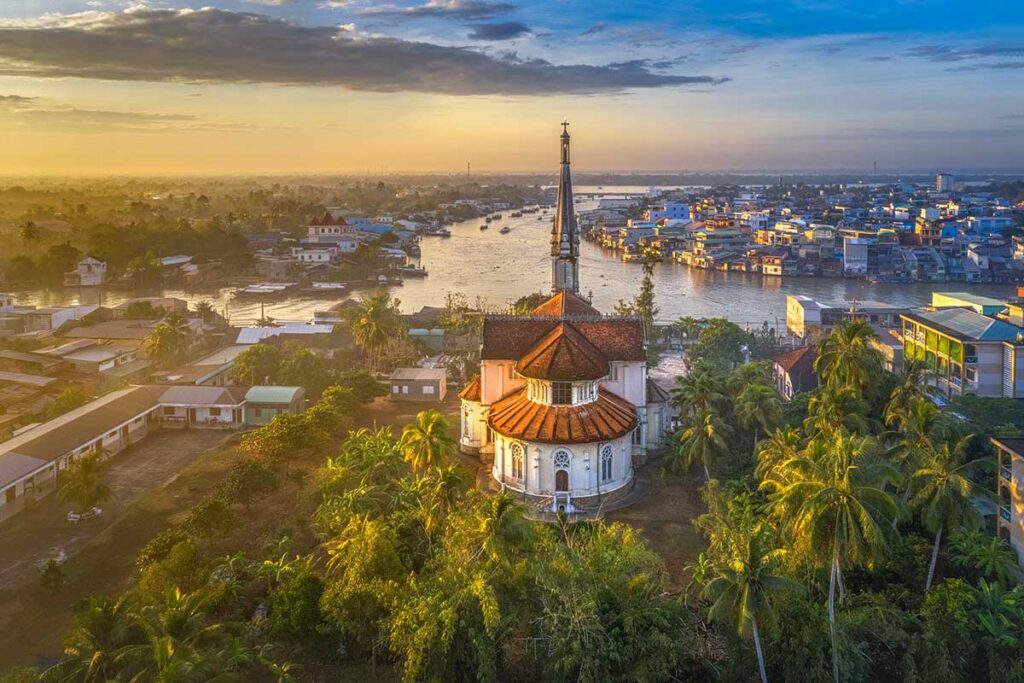What is Cai Be Church?
Iconic building of Cai Be
Cai Be Church is one of the most recognizable landmarks in Cai Be town, standing right on the riverbank where boats constantly pass by. For many visitors, the best way to see it is from the water during a boat tour, when the tall bell tower and riverside façade appear above the busy river scene.
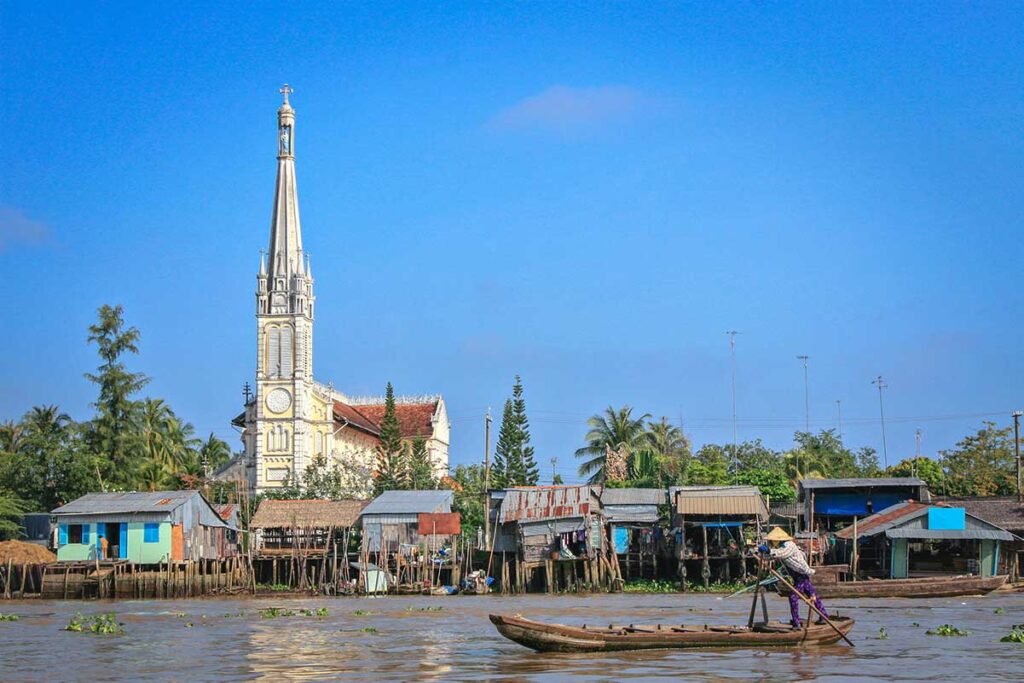
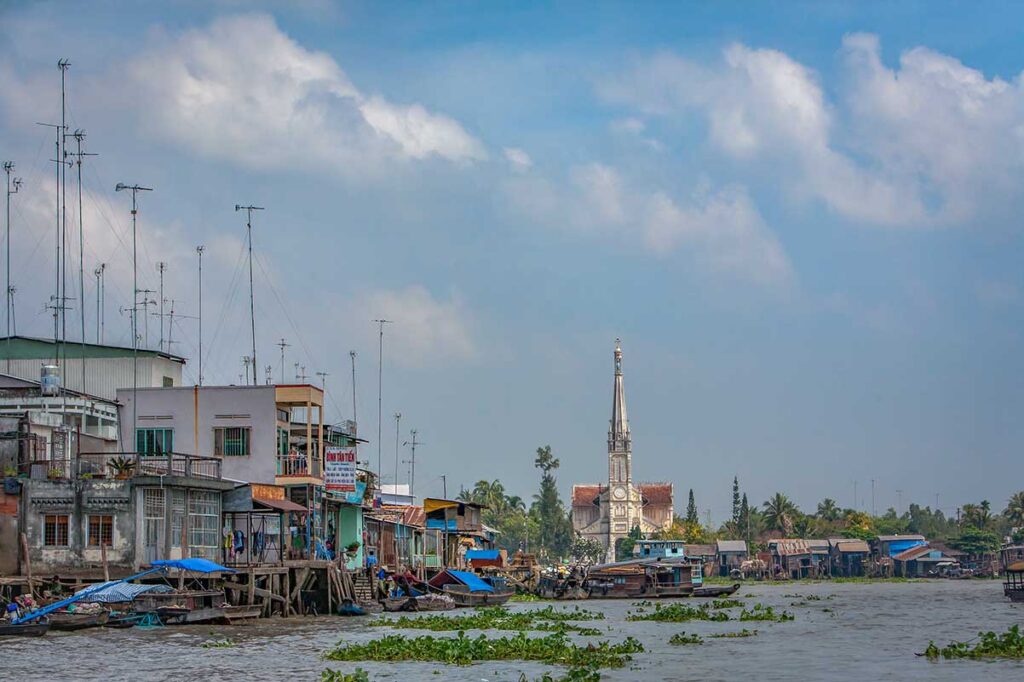
While you can go inside, the church is more of a symbolic structure than an essential interior attraction. For locals, however, it holds deep spiritual meaning and serves as both a place of worship and a cultural anchor in the community.
Brief history
The first version of Cai Be Church was built in 1869, made with wooden pillars and a thatched roof of water coconut leaves, serving a small parish community. As the Catholic population grew, a larger and more permanent structure was needed. The current church was constructed between 1929 and 1932 under the guidance of German priest Adolphe Keller, with significant support from local parishioners. Despite the ups and downs of the 20th century, the church still stands proudly today and remains notable for having the tallest bell tower in the Mekong Delta.
Architecture of Cai Be Church
Exterior
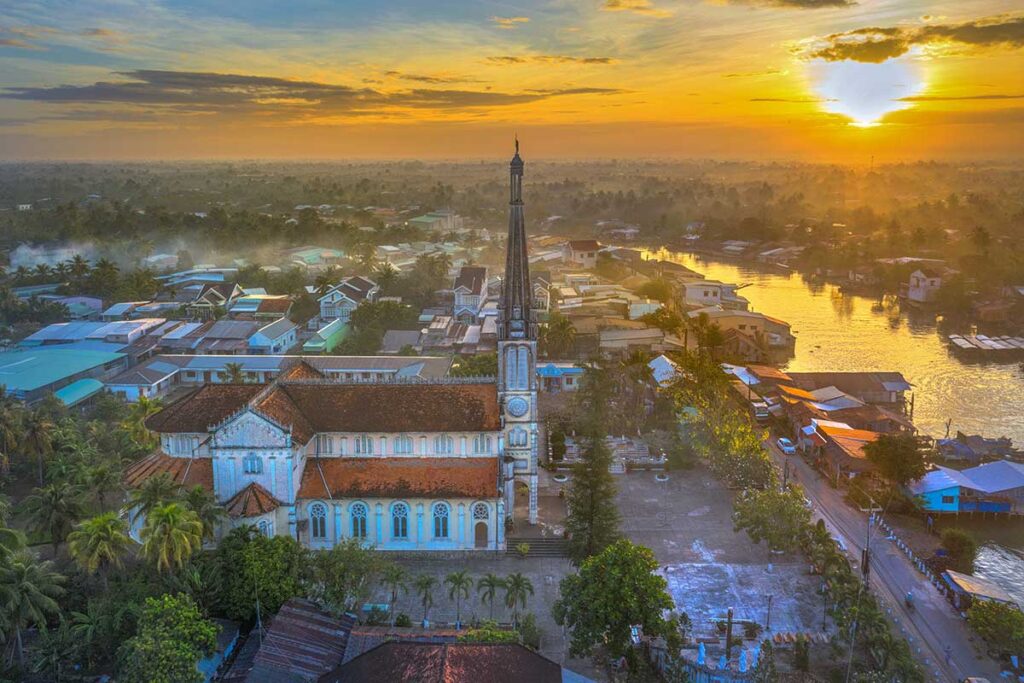
Cai Be Church was built in a Romanesque style, with rounded domes, arched windows, and detailed stonework that give it a distinctly European look. Its ground plan forms a large cross, something most noticeable from above, and the proportions between the wings and the body make it visually balanced.
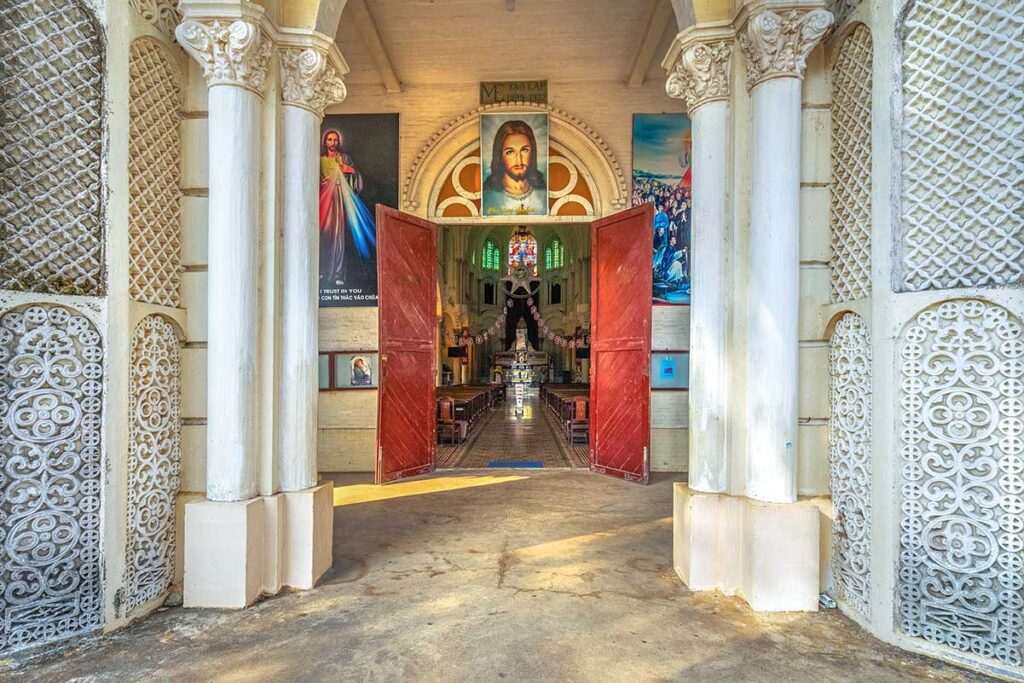
The church’s most striking feature is its bell tower, the tallest in the Mekong Delta, housing four bronze bells cast in France in 1931. The façade facing the river is decorated with carved vine patterns and topped by a statue of the Virgin Mary, making it especially photogenic when seen from a boat on the Cai Be floating market side.
Interior
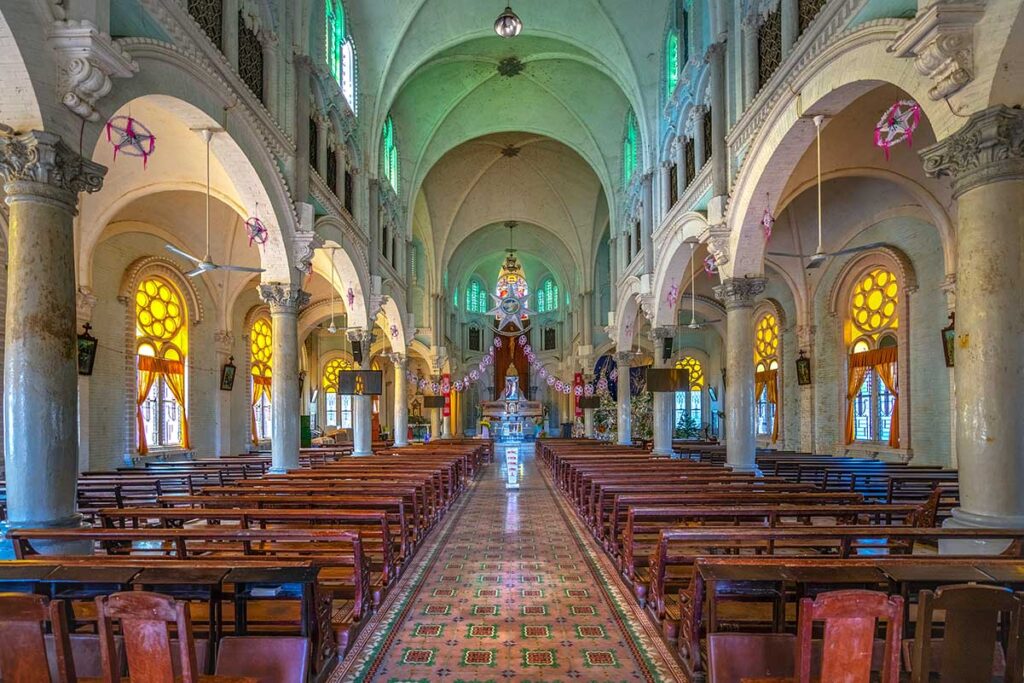
Inside, the church feels light and open, thanks to many windows that allow natural light to fill the space. The high dome is divided into zones with simple but tasteful decorations, creating a balance between grandeur and restraint. The sanctuary includes five marble altars, stained-glass windows, and paintings of the Stations of the Cross that add both color and solemnity.
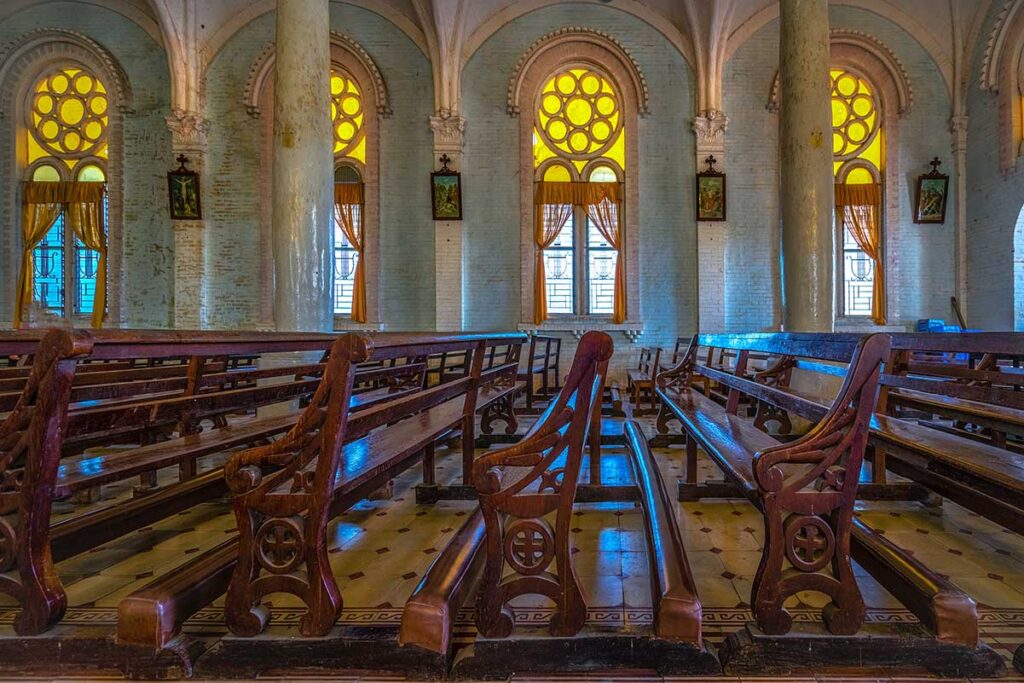
Neatly arranged rows of pews line the nave, giving the space a sense of order and reverence. While the design is impressive, it’s worth noting that the interior can get very hot during the day since there are no fans or air-conditioning. Visitors often find the atmosphere beautiful but a little uncomfortable in the Mekong Delta heat.
Visiting Cai Be Church
Location & Address
Cai Be Church is located in Cai Be town, Tien Giang Province, right on the banks of the Tien River where several waterways meet. Its position directly across from the Cai Be floating market makes it a popular subject for photos taken from the water, with the bell tower rising above the busy river scene.
Opening hours & Mass times
The church is generally open daily from around 5:00 AM until 5:30 PM. On Sundays, Mass is held throughout the day, usually between 5:00 AM and 5:00 PM. Entrance is free, though times may shift slightly depending on parish activities.
How to get there
Most travelers visit Cai Be Church as part of a broader Mekong Delta trip from Ho Chi Minh City, often combined with a boat tour of the Cai Be floating market and nearby canals. Cai Be is accessible by car, private transfer, or bus, and many tours include the church as a stop. For the best view, it’s worth seeing the church from a boat on the river rather than just from the road.
Dress code & etiquette
If you plan to step inside, wear modest clothing that covers shoulders and knees. Inside the church, it’s important to remain quiet and respectful, especially if Mass is in progress. Photography is allowed, but avoid using flash or walking through active services.
Honest take – is it worth going inside?
From the outside, Cai Be Church is one of the town’s most iconic sights, particularly when viewed from the water. The interior is attractive with stained glass and marble altars, but the lack of air-conditioning or fans can make it uncomfortably hot and stuffy during much of the day. It’s certainly worth a look if you’re already in Cai Be, but it’s not a destination worth traveling to on its own—its value lies in being part of a wider Mekong Delta experience.
Other things to do around Cai Be
Cai Be Church is best visited as part of a broader exploration of the town and its surroundings. There are several other places nearby that give you a fuller picture of life in this part of the Mekong Delta:
- Cai Be Floating Market – Once one of the busiest markets in the region, it’s now much smaller and less lively, but still offers a glimpse of local river trade, especially in the early morning.
- Ancient Houses (Ba Duc, Ba Kiet) – These well-preserved French-Vietnamese merchant homes showcase the blend of colonial and traditional architecture that flourished in Cai Be’s trading past.
- Dong Hoa Hiep Ancient Village – A quieter area where you can wander among traditional wooden houses, fruit orchards, and shady canals.
- Fruit Gardens & Sampan Rides – Visiting local orchards or taking a short paddle boat ride through narrow canals offers a hands-on look at rural Mekong life.
- Cao Dai Temple in Cai Be – A colorful and distinctive temple representing the Cao Dai religion, worth a short stop if you’re interested in Vietnam’s diverse spiritual traditions.
For a full overview of highlights, itineraries, and practical tips, see our complete Cai Be travel guide.
